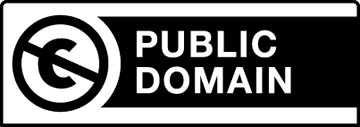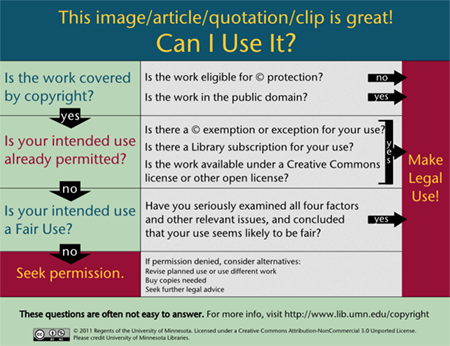Copyright is about balancing the rights of authors with the rights of the public to use the work without seeking permission or paying royalties.
Under copyright, authors have the right to control the use of their work, subject to exceptions permitted under the law. There are many ways to use content created by others without violating copyright law. The following are the four main ways to legally re-use content created by others.
Additional information about using content created by others is available from the campus libraries’ copyright pages or by contacting Carrie Nelson, Director of Scholarly Communication.
- Use Material that is in the Public Domain.

From: https://creativecommons.org/weblog/entry/41688 (CC BY 4.0)
The term "public domain" refers to creative materials that are not protected by intellectual property laws such as copyright, trademark or patent laws. The public owns these works rather than an individual author or artist. Anyone can use a public domain work without obtaining permission, but no one can ever own it.
The two main categories of easily-identifiable material in the public domain are U.S. Government works and works created before 1923. (Many other types of resources are in the public domain but it is more difficult and nuanced to determine the status of material in those categories.)
Optional Resources
-
Welcome to the Public Domain (Stanford University Libraries)
-
Copyright Term & the Public Domain (Cornell University)
- Use Material that is Associated with a License that Allows a Particular Use.
Licensed materials useful for course content are likely to be either library-licensed materials or “open” (usually Creative Commons-licensed) materials.
Library licenses vary, but generally allow anyone who is physically on campus or who has a campus user identification to access the licensed material. Usually the license does not allow for additional copies of the resources to be created, so the safest way to connect students with course content licensed through the library is to provide a library link rather than providing a copy of the file itself.
Creative Commons (CC) licenses are the most common type of open license. They broadly allow others to copy, distribute, and make some uses of work that is still under copyright protection. Open educational resources are associated by their creators with some type of open license.
In addition to allowing certain uses of copyrighted material, CC licenses place restrictions or requirements on those uses, too. Most require attribution of the original source, and some prohibit commercial use or require that the material incorporating the licensed-work is also associated with an open license. Details about the various types of CC licenses are available at their website.
- Make a Fair Use of the Material.

Think through fair use decisions with this useful tool.
Note: Will need to set up a guest account.
Copyright law makes it clear that materials subject to copyright restrictions still need to be available to re-use for socially valuable purposes such as teaching, news reporting, parody, or critical comment. This is called "fair use."
In its most general sense, a fair use is any copying of copyrighted material done for a limited and "transformative" purpose such as to comment upon, criticize, or parody a copyrighted work. Such uses can be done without permission from the copyright owner.
Unfortunately, the only way to get a definitive answer on whether a particular use of a resource is a fair use is to have it resolved in federal court. Judges use four factors in resolving fair use disputes:
-
purpose and character of use;
-
nature of the copyrighted work;
-
amount and substantivity of the portion taken; and
-
effect of the use upon the potential market.
A more detailed description of the four factors is available from the Columbia University libraries.
Fair Use is a Balancing Test
All four factors need to be considered in determining whether or not a use is fair. Not all factors need to weigh for or against fair use, but will usually lean one direction or the other. University of Minnesota libraries' Thinking Through Fair Use Tool walks through the decision-making process and generates an email to help document the decision.
Optional Resources
-
What is Fair Use? Copyright Advisory Office, Columbia University Libraries.
-
The 'Fair Use' Rule: When Use of Copyrighted Material is Acceptable
- Get Permission for a Particular Use from the Copyright Holder.
If your intended use exceeds copyright restrictions on a particular work and you cannot make a fair use argument, you should seek permission from the copyright owner.
Following is a permissions process:
-
Determine the copyright owner. This could be the publisher, author, artist, photographer, videographer, etc.
-
Contact the copyright holder for each object you plan to use. Many commercial publishers use the Copyright Clearance Center to arrange for paid permissions.
-
Include the following in your permission request:
-
your name and contact information,
-
the object you wish to use,
-
how you intend to use the object,
-
what format you will use,
-
whether your use is for educational or commercial purposes,
-
why you want to use the object; and
-
your intention to acknowledge the author/creator and in what format.
-
Keep a record of all correspondence.
Optional Resources:
-
The Basics of Getting Permission (Stanford University Libraries)
- Use Images with the Considerations of Accessibility and Copyright to Illustrate Online Course Content from UCF’s Teaching Online Pedagogical Repository